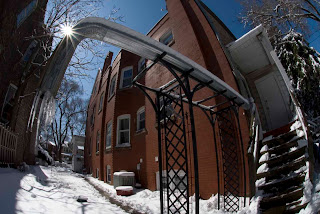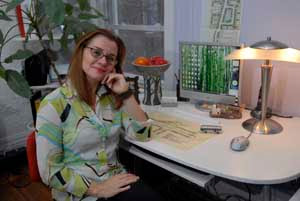Tuesday, June 24, 2008
InterAmerican garden
On June 7 the entire InterAmerican community got together to celebrate the "sustainable life" curriculum we've created and plant more than 30 fruit trees donated by the Fruit Tree Planting Foundation from California. We also created a rain garden designed by the 5th grade kids with the assistance of Jennifer Weber from Wolff Landscape Architecture and Carmen Vidal-Hallett. We also celebrated the final construction of the school's Chinampa Vegetable Garden, created with the assistance of the Organic School Project. The Chicago Cubs also had an important role with major funding. Jody Luna, permaculture expert, was also there. Finally, last but not least, Partners of America provided funding and volunteers and the connection with the partner states Illinois and Sao Paulo, giving this project the potential to be recreated in Sao Paulo too. Click here to see a slide show we created on the garden planting.
Saturday, April 19, 2008
Rain Garden in Winter
Wednesday, April 2, 2008
Curitiba Exhibit Teams Up With Cafe Igarai Artwork at Metropolis

Invitation for Metropolis Cafe
Sunday, April 6, 6:30pm to 8:00pm
Dear friends,
We are happy to invite you for the opening of an exciting exhibit at Metropolis Café in Chicago, this Sunday, April 6, 2008, from 6:30pm to 8:00 pm.
Address: 1039 W. Granville Ave, Chicago, phone: 773 -764 0400
site: www.metropoliscoffee.com
The exhibit is about Sustainability in Brazil: a rural and an urban project.
The theme of the rural project is crafts with coffee as a theme by the group Café Igarai.
The theme of the urban project is Curitiba, a city that is a model of sustainability.
Below you will find more detailed information about the two joint exhibits.
Sustainability in Rural Brazil
Fazenda Ambiental Fortaleza – an organic coffee farm
Mococa – Sao Paulo
Cafe Igarai is a project designed first for the women who live at Fazenda Ambiental Fortaleza, which grew into the neighboring village of Igarai. The women work in the coffee fields but that takes only 4 to 5 months of the year. So the project has the purpose of giving them another source of income. The theme of their embroidery is coffee. They were encouraged to draw what they see, their working environment: coffee trees, beans, cups, terraces, etc. The women are descendants of Italian immigrants so embroidery is very much part of their culture. They knew mostly only cross stitches when they started, but they had a natural talent for learning very fast all the new stitches they were taught.
The exhibit was designed to show and tell who these women are and how they started. We can see their faces, read a little about them. At the bottom of the banners are the original exams at the end of their training course: the new stitches they learned. The embroidered pictures that are for sale for $150.00 are a way to fundraise for them. The fabrics were natural dyed, another of their new skills, and all designs are theirs. Highlighting the importance of original design, natural dyeing and elaborate embroidery and crochet as a means of expression, as well as coffee as a theme is important to encourage them to evolve in a way that supports the development or their own identity. The prices of other items range from $9.00 to $28.00.
Fazenda Ambiental Fortaleza sells its gourmet organic coffee to Metropolis Café.
See www.fafbrazil.com and www.igarai.blogspot.com
"Sustainability in the Big City:
What Chicago Can Learn From Curitiba"
This exhibit is an overview of the sustainable city of Curitiba in southern Brazil and lessons it offers our own environmental efforts here in Chicago. Curitiba has been at the forefront in urban sustainability for more than 30 years with outstanding policies in transit-oriented development and bus rapid transit (BRT), sustainable zoning, green space, architecture preservation, affordable housing, recycling and environmental education. This project was funded by the Graham Foundation for Advanced Studies in Architecture and is posted on the Center for Neighborhood Technology's web site. For more information contact Carmen Vidal-Hallett, LEED AP, International Associate AIA at cvidalhallett@gmail.com.
http://www.fafbrasil.com/fafbr/ip.asp?op=C-Metropolis&sc=C&m=xC00200Programs&lg=E
Saturday, February 9, 2008
Sustainable Life at Interamerican

Photo captions: InterAmerican kids learn to calculate rain garden size (top photo)

Andre Bispo de Jesus, a gardener from Bahia, Brazil teaching kids (middle)

Kids growing veggies in the classroom (bottom)
In December of 2007 the program started with the Aztec market created by the teachers and students and filmed by Columbia College students and with my kick off presentation about the "Chinampa/Rain Garden", the first project of a potential "Sustainable Master Plan" for IAMS. We also showed the kids the movie www.storyofstuff.com right before the holidays which was a perfect time to make them think about not being so materialist when asking for present and to prepare their minds for the future lessons.
The idea was to teach sustainability by using the present 5th curriculum. The kids at IAMS focus every year on a unique culture of the Americas. The Aztecs are the focus in 5th grade as well as the Cahokia Indian American Culture in Illinois. They also learn a lot about the Human Body and Nutrition. In Math they concentrate on fractions, decimals, percentage, division, etc.
After a productive discussion with the teachers we concluded that a "Chinampa/Rain Garden" project would be an ideal project for the kids related to the curriculum. (A Chinampa is a floating vegetable garden created by the Aztecs and a true example of sustainable agriculture).
In January of 2008 the kids learned about the basics of the rain garden and how to calculate the area of the rain garden we are going to build in the spring. Mr. Carmona, a 5th grade teacher and specialist in math, assisted in the calculation showing the kids how to use the math concepts the kids are reviewing. The result was great! We went outside and measured the roof area of the gutters we will use for our rain garden, made the calculation and designed the basic area of the garden. Also in January we taught the kids how to start to grow the vegetables. Andre and I did a gardening demonstration of how to plant in the classroom and the kids loved putting their hands in the potting soil and learning about vegetables! It was a lot of fun for all of them.
February promises to be as exiting with landscaping lessons from Jennifer Weber and permaculture concepts from Jody Luna. If time allows I will be teaching the children how to design the minimal house based on Aztecs houses which were built by the Aztecs adjacent to the Chinampas.
More updates to come…
Sunday, January 27, 2008
Evanston Lakefront Master Plan
The results of the Lakefront Master Plan in Evanston will bring back native landscape including dune restoration, prairie land and a completely bike path and pedestrian routes and handicap accessibility everywhere. I worked with the EDAW team as part of UrbanWorks Architecture on this project. We created several alternatives and completed an exhaustive community process. Click here for the consensus draft master plan: http://www.cityofevanston.org/departments/parks/pdf/10-04-2007draftconsensusplan_000.pdf.
Subscribe to:
Posts (Atom)

